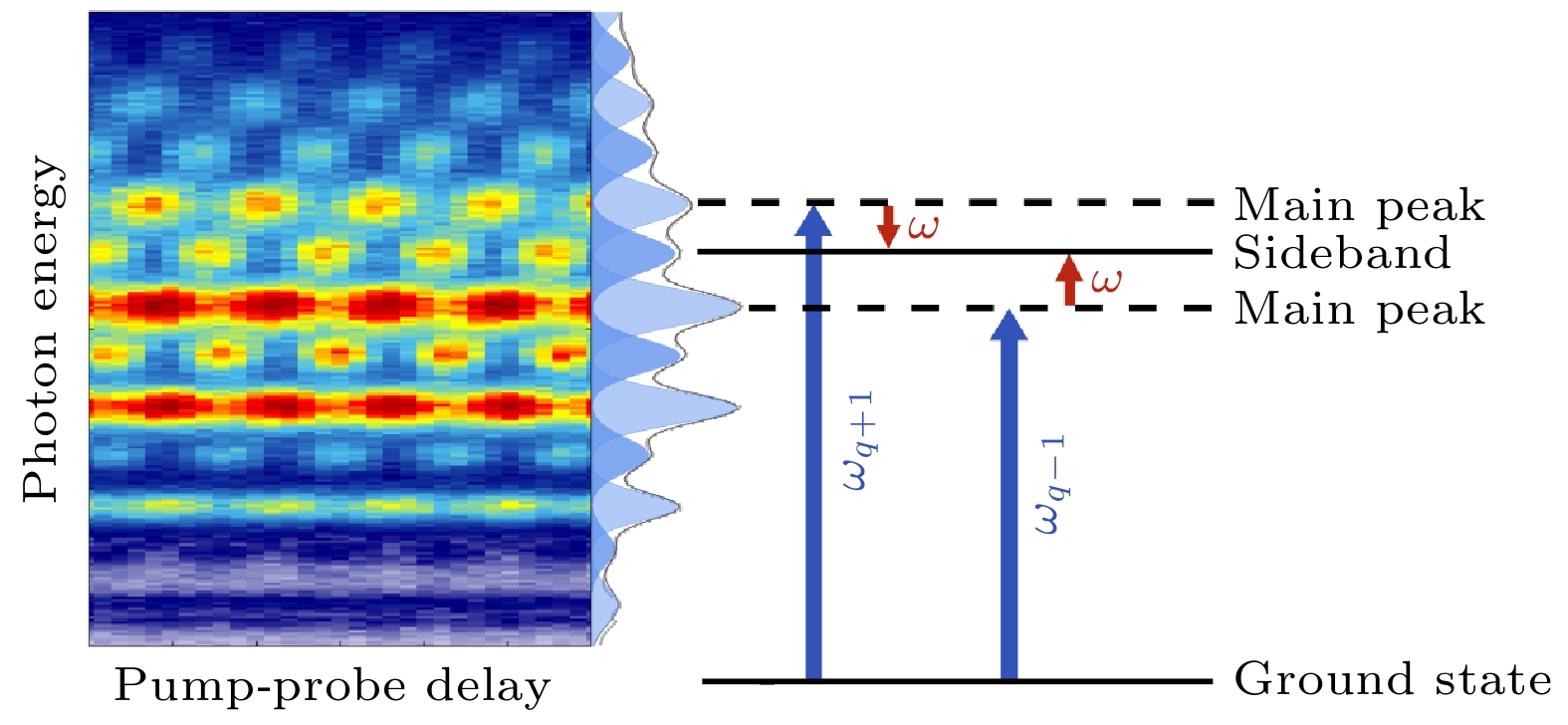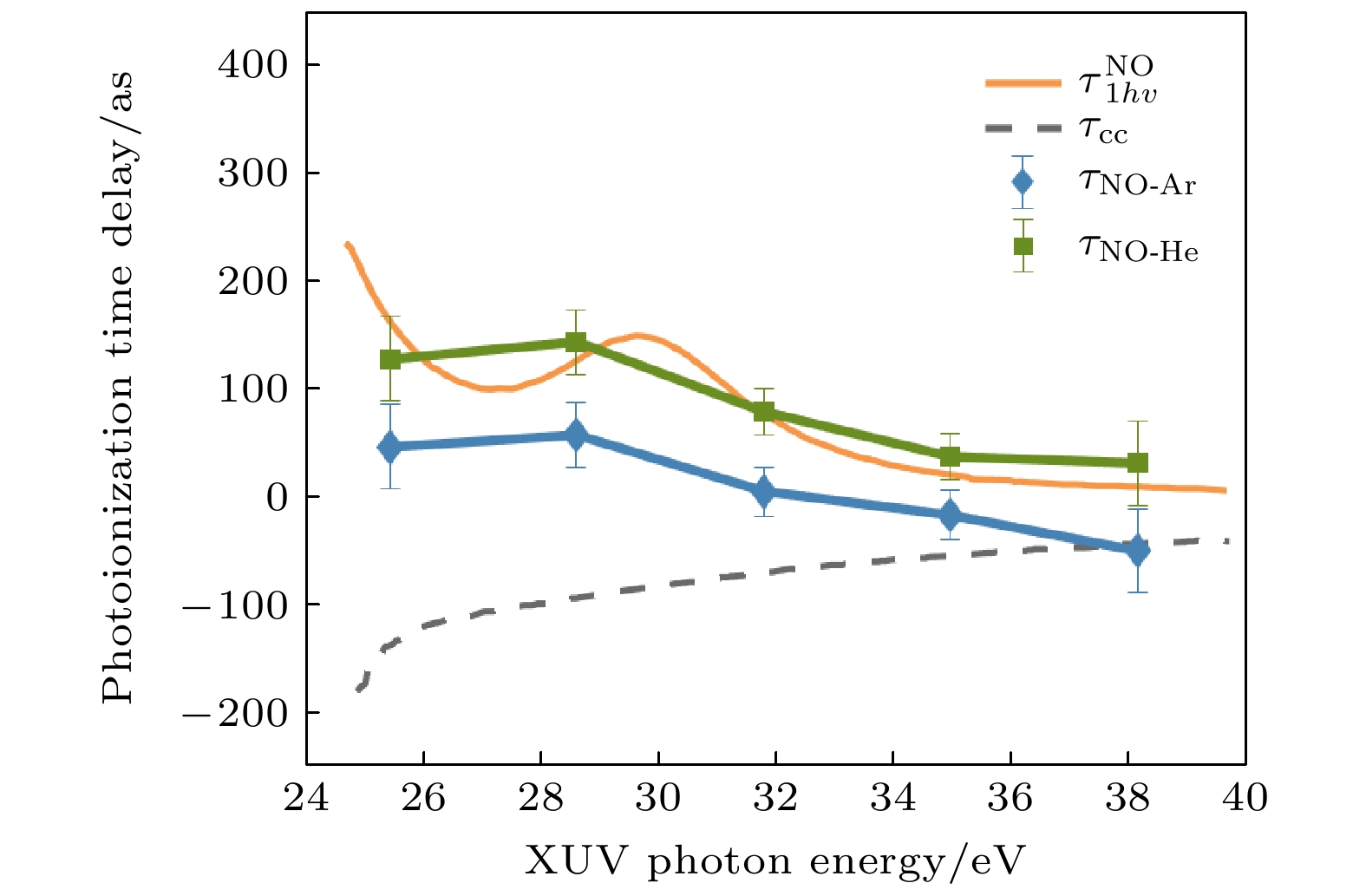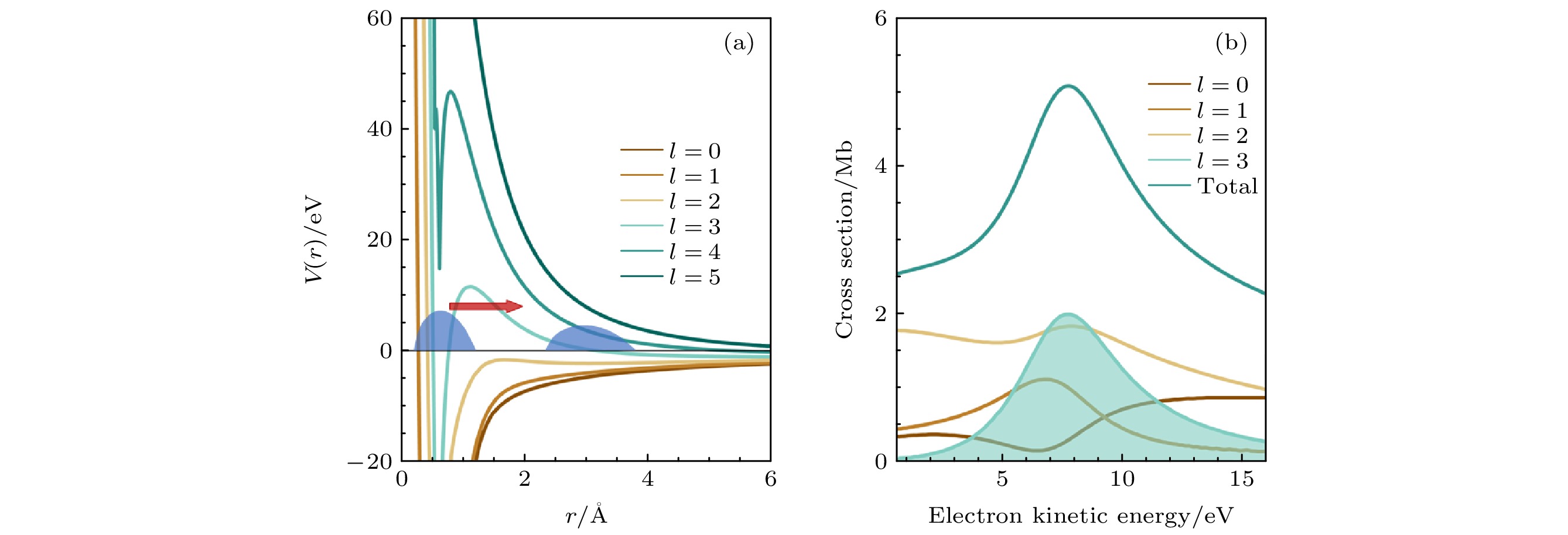-
形状共振是分子电离散射过程中的一种重要现象, 其阿秒量级的光电离延时的精密测量, 是深入认识形状共振过程及成因的重要基础. 本文使用基于近红外飞秒激光与极紫外阿秒脉冲串的阿秒符合干涉仪, 利用双光子干涉的阿秒拍频重构的探测方法, 对一氧化氮(NO)分子4σ电子的形状共振过程进行研究, 实验测量了分子内有效电离延时对光子能量的依赖关系, 通过对比双光子跃迁延时与单光子跃迁延时, 发现单光子过程的Wigner延时是双光子跃迁延时随能量变化的主要原因. 基于单中心展开的量子散射理论计算表明, 在分子形状共振位置的电子电离延时, 主要由连续态中高角动量离心势囚禁的电子决定.Shape resonance is an important and ubiquitous phenomenon in the process of molecular scattering and photoionization. The study of the attosecond photoemission time delay in the vicinity of the shape resonance is of great significance for understanding its intrinsic origin on a nature time scale of electron motion. In this paper, an advanced attosecond coincidence interferometer consisting of a near-infrared femtosecond light source and an extreme ultraviolet attosecond pulse train is used to study the shape resonance process of the 4σ electron of nitric oxide molecules via reconstructing attosecond harmonic beating by measuring the interference of two-photon transitions (RABBIT). The energy dependent effective ionization time delay in the vicinity of the resonance energy region is reported. By comparing the relationship between the two-photon transition delay and the one-photon transition delay, it is found that the Wigner delay of the single-photon process is the main reason for the two-photon transition delay changing with energy. The effect of continuum-continuum delay is further explored. Theoretical calculations of the initial state (bound state) and final state (resonance state) electron wave function orbits of the resonance show that the shape resonance assisted time delay is dominated by the electrons trapped in the centrifugal potential barrier.
-
Keywords:
- shape resonance /
- attosecond photoionization time delay /
- attosecond coincidence interferometer
[1] Charron E, Giusti-Suzor A, Mies F H 1993 Phys. Rev. Lett. 71 692
 Google Scholar
Google Scholar
[2] Stapelfeldt H, Seideman T 2003 Rev. Mod. Phys. 75 543
 Google Scholar
Google Scholar
[3] Lafosse A, Lebech M, Brenot J C, Guyon P M, Jagutzki O, Spielberger L, Vervloet M, Houver J C, Dowek D 2000 Phys. Rev. Lett. 84 5987
 Google Scholar
Google Scholar
[4] Nandi S, Plésiat E, Zhong S, Palacios A, Busto D, Isinger M, Neoričić L, Arnold C L, Squibb R J, Feifel R, Decleva P, L’Huillier A, Martín F, Gisselbrecht M 2020 Sci. Adv. 6 eaba7762
 Google Scholar
Google Scholar
[5] Huppert M, Jordan I, Baykusheva D, Von Conta A, Wörner H J 2016 Phys. Rev. Lett. 117 093001
 Google Scholar
Google Scholar
[6] Gong X, Heck S, Jelovina D, Perry C, Zinchenko K, Lucchese R, Wörner H J 2022 Nature 609 507
 Google Scholar
Google Scholar
[7] Jiang W, Armstrong G S J, Tong J, Xu Y, Zuo Z, Qiang J, Lu P, Clarke D D A, Benda J, Fleischer A, Ni H, Ueda K, van der Hart H W, Brown A C, Gong X, Wu J 2022 Nat. Commun. 13 5072
 Google Scholar
Google Scholar
[8] Kling M F, Siedschlag C, Verhoef A J, Khan J I, Schultze M, Uphues T, Ni Y, Uiberacker M, Drescher M, Krausz F, Vrakking M J J 2006 Science 312 246
 Google Scholar
Google Scholar
[9] Gong X, Song Q, Ji Q, Pan H, Ding J, Wu J, Zeng H 2014 Phys. Rev. Lett. 112 243001
 Google Scholar
Google Scholar
[10] Fermi E, Amaldi E, D’Agostino O, Rasetti F, Segrè E 1934 Proc. R. Soc. London. Ser. A, Contain. Pap. Math. Phys. Character 146 483
 Google Scholar
Google Scholar
[11] Bohr N 1936 Nature 137 344
 Google Scholar
Google Scholar
[12] Henson A B, Gersten S, Shagam Y, Narevicius J, Narevicius E 2012 Science 338 234
 Google Scholar
Google Scholar
[13] Schulz G J 1973 Rev. Mod. Phys. 45 423
 Google Scholar
Google Scholar
[14] Palmer R E, Rous P J 1992 Rev. Mod. Phys. 64 383
 Google Scholar
Google Scholar
[15] Martin F, Burrow P D, Cai Z, Cloutier P, Hunting D, Sanche L 2004 Phys. Rev. Lett. 93 6
 Google Scholar
Google Scholar
[16] Kennedy D J, Manson S T, 1972 Phys. Rev. A 5 227
 Google Scholar
Google Scholar
[17] Rist J, Klyssek K, Novikovskiy N M, Kircher M, Vela-Pérez I, Trabert D, Grundmann, S, Tsitsonis D, Siebert J, Geyer A, Melzer N, Schwarz C, Anders N, Kaiser L, Fehre K, Hartung A, Eckart S, Schmidt L P H, Schöffler M S, Davis V T, Williams J B, Trinter F, Dörner R, Demekhin P V, Jahnke T 2021 Nat. Commun. 12 6657
 Google Scholar
Google Scholar
[18] Paul P M, Toma E S, Breger P, Mullot G, Augé F, Balcou P, Muller H G, Agostini P 2001 Science 292 1689
 Google Scholar
Google Scholar
[19] Heck S, Baykusheva D, Han M, Ji J B, Perry C, Gong X, Wörner H J 2021 Sci. Adv. 7 eabj8121
 Google Scholar
Google Scholar
[20] Ahmadi H, Plésiat E, Moioli M, Frassetto F, Poletto L, Decleva P, Schröter C D, Pfeifer T, Moshammer R, Palacios A, Martin F, Sansone G 2022 Nat. Commun. 13 1242
 Google Scholar
Google Scholar
[21] Holzmeier F, Joseph J, Houver J C, Lebech M, Dowek D, Lucchese R R 2021 Nat. Commun. 12 7343
 Google Scholar
Google Scholar
[22] Gong X, Jiang W, Tong J, Qiang J, Lu P, Ni H, Lucchese R, Ueda K, Wu J 2022 Phys. Rev. X 12 011002
 Google Scholar
Google Scholar
[23] Wallace S, Dill D, Dehmer J L 1982 J. Chem. Phys. 76 1217
 Google Scholar
Google Scholar
[24] Suzuki Y I, Tang Y, Suzuki, T. 2012 Phys. Chem. Chem. Phys. 14 7309
 Google Scholar
Google Scholar
[25] Baykusheva D, Kraus P M, Zhang S B, Rohringer N, Wörnera H J 2014 Faraday Discuss. 171 113
 Google Scholar
Google Scholar
[26] Veyrinas K, Saquet N, Marggi Poullain S, Lebech M, Houver J C, Lucchese R R, Dowek D 2019 J. Chem. Phys. 151 174305
 Google Scholar
Google Scholar
[27] Vos J, Cattaneo L, Patchkovskii S, Zimmermann T, Cirelli C, Lucchini M, Kheifets A, Landsman A S, Keller U 2018 Science 360 1326
 Google Scholar
Google Scholar
[28] Popmintchev T, Chen M C, Arpin P, Murnane M M, Kapteyn H C 2010 Nat. Photonics 4 822
 Google Scholar
Google Scholar
[29] McPherson A, Gibson G, Jara H, Johann U, Luk T S, McIntyre I A, Boyer K, Rhodes C K 1987 J. Opt. Soc. Am. B 4 595
 Google Scholar
Google Scholar
[30] Corkum P B 1993 Phys. Rev. Lett. 71 1994
 Google Scholar
Google Scholar
[31] Dörner R, Mergel V, Jagutzki O, Spielberger L, Ullrich J, Moshammer R, Schmidt-Böcking H 2000 Phys. Rep. 330 95
 Google Scholar
Google Scholar
[32] Wigner E P 1955 Phys. Rev. 98 145
 Google Scholar
Google Scholar
[33] Smith F T 1960 Phys. Rev. 118 349
 Google Scholar
Google Scholar
[34] Dahlström J M, Guénot D, Klünder K, Gisselbrecht M, Mauritsson J, L’Huillier A, Maquet A, Taïeb R. 2013 Chem. Phys. 414 53
 Google Scholar
Google Scholar
[35] Gong X, Jordan I, Huppert M, Heck S, Baykusheva D, Jelovina D, Schildand A. Wörner H J 2022 CHIMIA 76 520
 Google Scholar
Google Scholar
[36] Natalense A P, Lucchese R R 1999 J. Chem. Phys. 111 5344
 Google Scholar
Google Scholar
[37] Gianturco F A, Lucchese R R, Sanna N 1994 J. Chem. Phys. 100 6464
 Google Scholar
Google Scholar
[38] Combes J M, Duclos P, Klein M, Seiler R 1987 Commun. Math. Phys. 110 215
 Google Scholar
Google Scholar
[39] Grumbling, E. R, Sanov, A. 2011 J. Chem. Phys. 135 064302
 Google Scholar
Google Scholar
[40] Zare R N 1972 Mol. Photochem. 4 1
-
图 1 形状共振中电子隧穿过程示意图. 蓝色曲线为电子感受到的随电子到原子核距离r变化的离心势场. 电子发生形状共振时, 可被离心势垒短暂束缚, 之后隧穿进入连续态
Fig. 1. Schematic illustration of the electron tunneling process in shape resonance. The blue curve indicates the centrifugal potential of the electron as a function of the distance to the nuclei. During the shape resonance process, the electron is temporally trapped by the centrifugal potential barrier, and then tunnels into the continuum state.
图 2 泵浦探测实验光路示意图, 泵浦光为高次谐波产生的极紫外阿秒脉冲串(XUV-APT), 探测光为NIR, 两路光分别聚焦后作用在COLTRIMS中的超声分子束上产生正离子碎片与电子
Fig. 2. Schematic diagram of the pump-probe experiment. The pump light is extreme ultraviolet attosecond pulse train (XUV-APT) generated by high-order harmonics generation process, and the probe light is NIR. Positive ion fragments and electrons are generated on an ultrasonic molecular beam in COLTRIMS. Two beams are focused respectively and reach on the ultrasonic jet in COLTRIMS to generate positive ion fragments and electrons.
图 3 RABBIT原理示意图. 左图为实验采集的氩原子阿秒光电子能谱, 右侧为抽运探测时间积分后的光电子能谱, 包含主级次电子和边带电子. 边带电子通过从第q – 1级和第q + 1级主级次电子分别吸收和释放一个NIR光子产生的两条量子跃迁路径干涉产生
Fig. 3. Schematic diagram of RABBIT method. The left figure shows the experimentally measured attosecond photoelectron spectrum of argon atoms. The pump-probe time delay integrated photoelectron kinetic energy distribution is shown in the right panel including the main peaks and sidebands. The qth sideband electron is generated via the quantum interference between the pathways populated via the single NIR photon absorption and emission from the main peaks of the (q – 1)th and (q + 1)th order.
图 4 (a) NO 4σ基态电子波函数, N原子核位于z ≈ 0.60 Å, O原子核位于z ≈ –0.55 Å, 波函数相位符号分别用绿色、红色标记; (b) NO σ*共振态电子波函数, 该共振态处于局域电势中
Fig. 4. (a) Electron wavefunction distribution of NO 4σ ground state. The N and O nuclei is located at z ≈ 0.60 Å and z ≈ –0.55 Å. The sign of electron wave function is marked in green and red; (b) electronic wave function distribution of the σ* resonance state, which is trapped in a centrifugal potential in the classical presentation.
图 5 阿秒光电子能谱 (a) Ar原子3p电离通道(
${I_{\text{p}}} = 15.76\;{\text{eV}}$ ); (b) He原子1s电离通道(${I_{\text{p}}} = 24.58\;{\text{eV}}$ ); (c) NO分子$4\sigma $ 电离解离通道(${I_{\text{p}}} = 21.73\;{\text{eV}}$ )Fig. 5. Attosecond photoelectron spectra of the electron released from (a) Ar atom 3p state (
${I_{\text{p}}} = 24.58\;{\text{eV}}$ ); (b) He atom 1s state (${I_{\text{p}}} = 24.58\;{\text{eV}}$ ); (c) NO molecular 4σ orbital (${I_{\text{p}}} = 21.73\;{\text{eV}}$ ).图 6 实验测量的NO分子有效相对光电子电离延时
${\tau _{{\text{NO-Ar}}}}, $ $ {\tau _{{\text{NO-He}}}}$ , 以及理论计算单光子延时$\tau _{1 h\nu }^{{\text{NO}}}$ 、连续态传播跃迁延时${\tau _{{\text{cc}}}}$ Fig. 6. Experimentally measured effective photoemission time delay difference of
${\tau _{{\text{NO-Ar}}}}, {\tau _{{\text{NO-He}}}}$ and theoretically calculated one-photon delay$\tau _{1 h\nu }^{{\text{NO}}}$ and continuum-continuum transition time delay${\tau _{{\text{cc}}}}$ .图 7 基于ePolyScat单中心量子散射模型的单分波通道理论计算结果 (a) l = 0到l = 5的单分波离心势垒分布, 深蓝色包络为电子波包示意; (b) 不同分波通道的单光子电离散射截面随光电子动能的变化, 4σ形状共振共振能量在光电子动能8 eV附近
Fig. 7. Partial wave resolved theoretical result based on ePolyScat calculation: (a) Centrifugal potential distribution of each partial wave channel from l = 0 to l = 5. The dark blue envelope represents the electron wave packet; (b) one-photon ionization scattering cross section for different partial wave channels. The 4σ shape resonance energy is centered at the photoelectron kinetic energy of 8 eV
-
[1] Charron E, Giusti-Suzor A, Mies F H 1993 Phys. Rev. Lett. 71 692
 Google Scholar
Google Scholar
[2] Stapelfeldt H, Seideman T 2003 Rev. Mod. Phys. 75 543
 Google Scholar
Google Scholar
[3] Lafosse A, Lebech M, Brenot J C, Guyon P M, Jagutzki O, Spielberger L, Vervloet M, Houver J C, Dowek D 2000 Phys. Rev. Lett. 84 5987
 Google Scholar
Google Scholar
[4] Nandi S, Plésiat E, Zhong S, Palacios A, Busto D, Isinger M, Neoričić L, Arnold C L, Squibb R J, Feifel R, Decleva P, L’Huillier A, Martín F, Gisselbrecht M 2020 Sci. Adv. 6 eaba7762
 Google Scholar
Google Scholar
[5] Huppert M, Jordan I, Baykusheva D, Von Conta A, Wörner H J 2016 Phys. Rev. Lett. 117 093001
 Google Scholar
Google Scholar
[6] Gong X, Heck S, Jelovina D, Perry C, Zinchenko K, Lucchese R, Wörner H J 2022 Nature 609 507
 Google Scholar
Google Scholar
[7] Jiang W, Armstrong G S J, Tong J, Xu Y, Zuo Z, Qiang J, Lu P, Clarke D D A, Benda J, Fleischer A, Ni H, Ueda K, van der Hart H W, Brown A C, Gong X, Wu J 2022 Nat. Commun. 13 5072
 Google Scholar
Google Scholar
[8] Kling M F, Siedschlag C, Verhoef A J, Khan J I, Schultze M, Uphues T, Ni Y, Uiberacker M, Drescher M, Krausz F, Vrakking M J J 2006 Science 312 246
 Google Scholar
Google Scholar
[9] Gong X, Song Q, Ji Q, Pan H, Ding J, Wu J, Zeng H 2014 Phys. Rev. Lett. 112 243001
 Google Scholar
Google Scholar
[10] Fermi E, Amaldi E, D’Agostino O, Rasetti F, Segrè E 1934 Proc. R. Soc. London. Ser. A, Contain. Pap. Math. Phys. Character 146 483
 Google Scholar
Google Scholar
[11] Bohr N 1936 Nature 137 344
 Google Scholar
Google Scholar
[12] Henson A B, Gersten S, Shagam Y, Narevicius J, Narevicius E 2012 Science 338 234
 Google Scholar
Google Scholar
[13] Schulz G J 1973 Rev. Mod. Phys. 45 423
 Google Scholar
Google Scholar
[14] Palmer R E, Rous P J 1992 Rev. Mod. Phys. 64 383
 Google Scholar
Google Scholar
[15] Martin F, Burrow P D, Cai Z, Cloutier P, Hunting D, Sanche L 2004 Phys. Rev. Lett. 93 6
 Google Scholar
Google Scholar
[16] Kennedy D J, Manson S T, 1972 Phys. Rev. A 5 227
 Google Scholar
Google Scholar
[17] Rist J, Klyssek K, Novikovskiy N M, Kircher M, Vela-Pérez I, Trabert D, Grundmann, S, Tsitsonis D, Siebert J, Geyer A, Melzer N, Schwarz C, Anders N, Kaiser L, Fehre K, Hartung A, Eckart S, Schmidt L P H, Schöffler M S, Davis V T, Williams J B, Trinter F, Dörner R, Demekhin P V, Jahnke T 2021 Nat. Commun. 12 6657
 Google Scholar
Google Scholar
[18] Paul P M, Toma E S, Breger P, Mullot G, Augé F, Balcou P, Muller H G, Agostini P 2001 Science 292 1689
 Google Scholar
Google Scholar
[19] Heck S, Baykusheva D, Han M, Ji J B, Perry C, Gong X, Wörner H J 2021 Sci. Adv. 7 eabj8121
 Google Scholar
Google Scholar
[20] Ahmadi H, Plésiat E, Moioli M, Frassetto F, Poletto L, Decleva P, Schröter C D, Pfeifer T, Moshammer R, Palacios A, Martin F, Sansone G 2022 Nat. Commun. 13 1242
 Google Scholar
Google Scholar
[21] Holzmeier F, Joseph J, Houver J C, Lebech M, Dowek D, Lucchese R R 2021 Nat. Commun. 12 7343
 Google Scholar
Google Scholar
[22] Gong X, Jiang W, Tong J, Qiang J, Lu P, Ni H, Lucchese R, Ueda K, Wu J 2022 Phys. Rev. X 12 011002
 Google Scholar
Google Scholar
[23] Wallace S, Dill D, Dehmer J L 1982 J. Chem. Phys. 76 1217
 Google Scholar
Google Scholar
[24] Suzuki Y I, Tang Y, Suzuki, T. 2012 Phys. Chem. Chem. Phys. 14 7309
 Google Scholar
Google Scholar
[25] Baykusheva D, Kraus P M, Zhang S B, Rohringer N, Wörnera H J 2014 Faraday Discuss. 171 113
 Google Scholar
Google Scholar
[26] Veyrinas K, Saquet N, Marggi Poullain S, Lebech M, Houver J C, Lucchese R R, Dowek D 2019 J. Chem. Phys. 151 174305
 Google Scholar
Google Scholar
[27] Vos J, Cattaneo L, Patchkovskii S, Zimmermann T, Cirelli C, Lucchini M, Kheifets A, Landsman A S, Keller U 2018 Science 360 1326
 Google Scholar
Google Scholar
[28] Popmintchev T, Chen M C, Arpin P, Murnane M M, Kapteyn H C 2010 Nat. Photonics 4 822
 Google Scholar
Google Scholar
[29] McPherson A, Gibson G, Jara H, Johann U, Luk T S, McIntyre I A, Boyer K, Rhodes C K 1987 J. Opt. Soc. Am. B 4 595
 Google Scholar
Google Scholar
[30] Corkum P B 1993 Phys. Rev. Lett. 71 1994
 Google Scholar
Google Scholar
[31] Dörner R, Mergel V, Jagutzki O, Spielberger L, Ullrich J, Moshammer R, Schmidt-Böcking H 2000 Phys. Rep. 330 95
 Google Scholar
Google Scholar
[32] Wigner E P 1955 Phys. Rev. 98 145
 Google Scholar
Google Scholar
[33] Smith F T 1960 Phys. Rev. 118 349
 Google Scholar
Google Scholar
[34] Dahlström J M, Guénot D, Klünder K, Gisselbrecht M, Mauritsson J, L’Huillier A, Maquet A, Taïeb R. 2013 Chem. Phys. 414 53
 Google Scholar
Google Scholar
[35] Gong X, Jordan I, Huppert M, Heck S, Baykusheva D, Jelovina D, Schildand A. Wörner H J 2022 CHIMIA 76 520
 Google Scholar
Google Scholar
[36] Natalense A P, Lucchese R R 1999 J. Chem. Phys. 111 5344
 Google Scholar
Google Scholar
[37] Gianturco F A, Lucchese R R, Sanna N 1994 J. Chem. Phys. 100 6464
 Google Scholar
Google Scholar
[38] Combes J M, Duclos P, Klein M, Seiler R 1987 Commun. Math. Phys. 110 215
 Google Scholar
Google Scholar
[39] Grumbling, E. R, Sanov, A. 2011 J. Chem. Phys. 135 064302
 Google Scholar
Google Scholar
[40] Zare R N 1972 Mol. Photochem. 4 1
计量
- 文章访问数: 7682
- PDF下载量: 160
- 被引次数: 0














 下载:
下载:




















